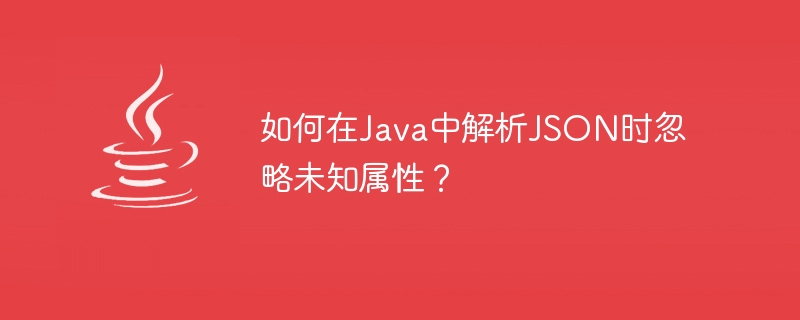

When processing JSON data in Java, developers may encounter unknown properties or fields that are not defined in the corresponding Java class. These unrecognized elements can cause problems during parsing, causing exceptions or data loss. To solve this problem, programmers can implement a mechanism to ignore such unknown properties when parsing JSON.
Properly configuring your JSON parser prevents unexpected properties from disrupting your application's functionality. JSON data can be parsed in a more robust and flexible way by skipping unrecognized properties and parsing only those that match the defined structure. This ensures that important information is not overlooked while unnecessary or invalid data is ignored.
Rephrase JSON format in Java is typically represented as a string and converted between Java objects using parsing and serialization libraries. These APIs allow parsing JSON strings into Java objects and vice versa, enabling integration between JSON-based systems and Java applications. This seamless communication facilitates easy data exchange between different systems.
There are several ways to ignore unknown properties when parsing JSON in Java. Here are some commonly used methods:
Jackson library with ObjectMapper
Gson library with GsonBuilder
JSON-B (Java API for JSON binding)
Manual parsing
This method involves configuring the ObjectMapper (a class provided by the Jackson library) by setting the DeserializationFeature.FAIL_ON_UNKNOWN_PROPERTIES feature to false. This allows the ObjectMapper to ignore unknown properties when parsing JSON, thus preventing exceptions from being thrown.
Create an instance of ObjectMapper.
Configure the ObjectMapper to set the DeserializationFeature.FAIL_ON_UNKNOWN_PROPERTIES feature to false.
Use ObjectMapper to parse JSON data into the required Java objects.
import com.fasterxml.jackson.databind.DeserializationFeature;
import com.fasterxml.jackson.databind.ObjectMapper;
public class JacksonExample {
public static void main(String[] args) throws Exception {
String jsonString = "{"name": "John", "age": 25, "unknownProperty": "Value"}";
ObjectMapper objectMapper = new ObjectMapper();
objectMapper.configure(DeserializationFeature.FAIL_ON_UNKNOWN_PROPERTIES, false);
Person person = objectMapper.readValue(jsonString, Person.class);
System.out.println(person);
}
}
class Person {
private String name;
private int age;
// Getters and setters
@Override
public String toString() {
return "Person{" +
"name='" + name + ''' +
", age=" + age +
'}';
}
}
Person{name='John', age=25}
To use the Gson library in this method, you need to create a Gson instance using the GsonBuilder class. This can be achieved by calling the setIgnoreUnknownProperties() method with the argument true. Doing so instructs Gson to ignore unknown properties during JSON parsing, ensuring they are not treated as errors.
Create an instance of GsonBuilder.
Call the setIgnoreUnknownProperties(true) method on the GsonBuilder instance.
Use GsonBuilder to build Gson objects.
Use Gson objects to parse JSON data into required Java objects.
import com.google.gson.Gson;
import com.google.gson.GsonBuilder;
public class GsonExample {
public static void main(String[] args) {
String jsonString = "{"name": "John", "age": 25, "unknownProperty": "Value"}";
Gson gson = new GsonBuilder()
.setIgnoreUnknownProperties(true)
.create();
Person person = gson.fromJson(jsonString, Person.class);
System.out.println(person);
}
}
class Person {
private String name;
private int age;
// Getters and setters
@Override
public String toString() {
return "Person{" +
"name='" + name + ''' +
", age=" + age +
'}';
}
}
Person{name='John', age=25}
To use JSON-B to ignore unknown properties, the Java class representing the JSON structure needs to be annotated with @JsonbTransient on the fields or properties that should be ignored. This annotation tells the JSON-B library to skip these properties during JSON parsing.
Annotate the Java class that represents the JSON structure using the @JsonbTransient annotation on the fields or properties to be ignored.
Use JSON-B implementation to parse JSON data into the required Java objects.
import javax.json.bind.Jsonb;
import javax.json.bind.JsonbBuilder;
public class JsonBExample {
public static void main(String[] args) {
String jsonString = "{"name": "John", "age": 25, "unknownProperty": "Value"}";
Jsonb jsonb = JsonbBuilder.create();
Person person = jsonb.fromJson(jsonString, Person.class);
System.out.println(person);
}
}
class Person {
private String name;
private int age;
// Getters and setters
@Override
public String toString() {
return "Person{" +
"name='" + name + ''' +
", age=" + age +
'}';
}
}
Person{name='John', age=25}
To parse JSON data using libraries such as org.json or json-simple, developers follow the approach of manually iterating over the keys and values of the JSON object. Developers can customize their desired parsing behavior by selectively processing identified properties and ignoring unknown properties.
Use JSON libraries such as org.json or json-simple to parse JSON data into JSON objects.
Iterate over the keys and values of a JSON object.
Process recognized properties and ignore any unrecognized or unknown properties during iteration.
import org.json.JSONObject;
public class ManualParsingExample {
public static void main(String[] args) {
String jsonString = "{"name": "John", "age": 25, "unknownProperty": "Value"}";
JSONObject jsonObject = new JSONObject(jsonString);
String name = jsonObject.optString("name");
int age = jsonObject.optInt("age");
Person person = new Person();
person.setName(name);
person.setAge(age);
System.out.println(person);
}
}
class Person {
private String name;
private int age;
// Getters and setters
@Override
public String toString() {
return "Person{" +
"name='" + name + ''' +
", age=" + age +
'}';
}
}
Person{name='John', age=25}
In this tutorial, when parsing JSON in Java, it is important to handle unknown properties appropriately to ensure robustness and flexibility in data processing. By configuring an ObjectMapper with Jackson, using Gson and GsonBuilder, leveraging JSON-B annotations, or manually parsing JSON data, developers can effectively ignore unknown properties and mitigate potential problems when parsing JSON in Java.
The above is the detailed content of How to ignore unknown properties when parsing JSON in Java?. For more information, please follow other related articles on the PHP Chinese website!
